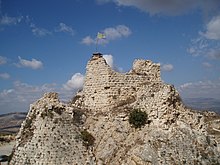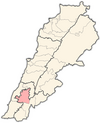Nabatieh
This article needs additional citations for verification. (September 2010) |
Nabatieh
النبطية | |
|---|---|
City | |
UTC+3 (EEST) | |
| Dialing code | +961 |


Nabatieh (Arabic: النبطية, Nabaṭiyya,
A market is held every Monday where traders and visitors from neighbouring villages gather in the centre of the town to exchange their goods in an area known in Arabic as the
Nabatieh was the birthplace of several learned men, including
Name
The most accepted theory is related to the Nabateans (spelled النبطي), an ancient Arab civilization that inhabited northern Arabia and the southern Levant. The name of the city colloquially is, النبطية meaning in a broader linguistic sense “the Nabatean” in a feminine form, a form which would have been used to name cities (e.g. Alexandria, Egypt). [3]
Alternatively, this form of the word may have been in the genitive case as well due to the presence of a definite article. In addition, the feminization may have been used for noun agreement, therefore the city may have been referred to in some variation by its early inhabitants as القرية النبطية , "the village of the Nabateans” or possibly some other toponym using the feminine form. Due to the city’s possible origins as a trading outpost (explained below), it could have also been السوق النبطية "the market of the Nabateans”, or some other variant which would have gradually been reduced to simply النبطية. [3]
The Nabatean Kingdom (3rd century BC – 106 AD) extended its greatest height between 85-71 BC in which they controlled Damascus. Between this period and the Roman period, there have been instances of Nabatean inscriptions and coinage in Sidon, which would have been the closest major port to Nabatieh. Therefore, being in the hinterland and at the foothills of the Lebanon mountains between Sidon and Damascus, the city may have been a trading stop or station for the Nabateans, thereby owing its name to them. One modern tradition that may have carried over from this ancient foundation is the weekly souk (souq el-tanen) which takes place every Monday and merchants from surrounding villages come to sell their goods. [3]
History
While the area has been inhabited since the Neolithic era (see Kfar Tebnit), the greatest archaeological discovery in the area to date occurred in the 1920s by Pierre Giugues while surveying necropolises in the area. Giugues found two arrowheads, one of which had a Phoenician inscription (KAI 20) which reads: arrow of Addo, son of Akki. This arrowhead was dated based on its paleography to the 10th century BCE. [4] It is currently housed in the Louvre. [5] Guigues also claimed that the tomb in which the arrows were found was reused into the Hellenistic period. This discovery occurred on a tell between lower and upper Nabatieh called “el-Ruwisseh” (area of what is now Ned el-Shqif) [6].
In the 1596
In 1875,
During Israel’s first full scale invasion of Lebanon,
Following the 1982 Israeli invasion of southern Lebanon, in October 1983 an Israeli Army convoy accidentally drove into Nabatieh at the height of the Ashura celebrations. In the ensuing confrontation a jeep was overturned and set on fire. The soldiers responded with rifle fire and grenades and one person was killed and several wounded. This incident, as well as the assassination of Sheikh Ragheb Harb, is seen as the turning point in the Shia community’s relationship with the occupying Israelis.[11]
After Israel’s withdrawal in 1985 Nabatieh was on the edge of the so-called security zone.
On 24 August 1989 an IAF air strike on Ain Abu Suwar near Nabatieh killed nine people. Reports stated that the dead were refugees from the fighting in Beirut.[12] In early December the same year Nabatieh was shelled for three days by the South Lebanon Army. Four people were killed and eighteen wounded.[13]
On 17 May 1991 two bombs exploded in Nabatieh killing four people including a member of the South Lebanon Army. A statement from the Islamic Jihad Organization claimed responsibility.[14] Five months later the area around Nabatieh was subjected to eight days of shelling by the South Lebanon Army and the Israeli Army. The bombardment culminated on 1st November with a series of IAF airstrikes which destroyed two bridges between Nabatieh and Iqlim al Tuffah. The Israeli offensive coincided with the start of the Madrid Peace Conference.[15]
During Operation Accountability, 25-31 July 1993, Nabatieh was extensively damaged by Israel artillery fire and airstrikes. Fifty-five towns and villages were heavily damaged during the offensive.[16]
The Israeli Army shelled Nabatieh again on 21 March 1994; during the bombardment a school was hit killing a twelve year old girl and wounding twenty-two others. Earlier in the day Hezbollah had killed two Israeli soldiers and three SLA militiamen.[17] Just over four months later, 4 August, the Israeli Air Force launched three airstrikes in the Nabatieh area which killed eight people and wounded eighteen.[18] On 20 October Israeli shelling killed five people in Nabatieh. The day before the SLA had killed two civilians after their patrol hit a land mine.[19] The shelling originated from the IDF military outpost base, Dabshe, which was situated on a hill overlooking Nabatieh.[20] The following week, 29 October, twenty Hizbollah fighters overran and set fire to the base. A video later broadcast by al-Manar showing the Hezbollah flag flying over the Israeli base caused a sensation. At the time it was estimated that Nabatieh had a population of 60,000.[21][22]
On 14 March 1995 the Lebanese
During Operation Grapes of Wrath by the Israeli Army, 18 April 1996, nine members of one family in Nabatieh were killed in the seventeen day bombardment when their house was destroyed.[26]
Historic structures
Beaufort Castle
On the top of a hill overlooking the southern Beqaa Valley towards Damascus stands Belfort or Beaufort castle, known to Arab travellers as Shqif Arnun, the word shqif being a Syriac term meaning high rock. The castle, although looking inaccessible, can be reached with little difficulty from the village of Arnoun, which lies 7 kilometres (4.3 mi) southeast of Nabatieh. There is no conclusive evidence for the age of this castle or for who built it.
The Crusaders repaired and fortified Beaufort Castle during the twelfth century and it became the most important fortress in Lebanon.
Mosques
Nabatieh has two historic mosques. One was built in the 16th century and lies in the centre of the town. Another, known as "the Mosque of the Prophet," dates to the
Education
Mission laïque française Lycée Franco-Libanais Habbouche-Nabatieh is located few km to the north of the city. The National Evangelical School (Known Previously as American School for Girls in Nabatieh) The Christian College Notre Dame des Soeurs Antonines is one of the oldest institutions in the city.[27]
Demographics
The inhabitants of Nabatieh are predominantly
People from Nabatieh
- Ahmad Rida (1872 – 1953)
- Muhammad Jaber Al Safa (1875 – 1945)
- Ahmed Aref El-Zein (1884 – 1960)
- Hassan Kamel Al-Sabbah (1894 – 1935)
- Hisham Jaber (1942 – )
- Yassine Jaber (1951- )
References
- ^ "World Gazetteer: Lebanon - largest cities (Per geographical entity)". Archived from the original on 16 March 2006. Retrieved 16 March 2006.
- ^ "World Gazetteer: Lebanon - largest cities (Per geographical entity)". Archived from the original on 25 June 2013. Retrieved 3 August 2015.
- ^ a b c https://www.academia.edu/118014974/History_of_Nabatieh_Lebanon_Prehistory_to_Antiquity_
- doi:10.3406/mefao.1926.990. Retrieved 23 July 2022., j'ai, au cours d'une mission d'exploration et de sondages archéologiques (1), procédé à une reconnaissance préliminaire de la nécropole sise à cet endroit.
Au lieu dit Roueisseh, près de Nabatiyet el-fôqa, à gauche de la route Saïda-Gedeideh Marg'ayoun, qui traverse l'immense atelier préhistorique de Qal'at-es-saqîf
- ^ https://collections.louvre.fr/en/ark:/53355/cl010143583
- ^ https://www.academia.edu/118014974/History_of_Nabatieh_Lebanon_Prehistory_to_Antiquity_
- ^ Hütteroth and Abdulfattah, 1977, p. 185
- ^ Note that Rhode, 1979, p. 6 writes that the register that Hütteroth and Abdulfattah studied was not from 1595/6, but from 1548/9
- ^ Guérin, 1880, p. 520
- ISBN 1-85043-025-Xpp. 179-180 quoting 21 March 1978 edition
- ISBN 978-0-571-23741-8pp.200-201
- ^ Middle East International No 358, 8 September 1989, Publishers Lord Mayhew, Dennis Walters MP; Fourteen days in brief p.14
- ^ Middle East International No 365, 15 December 1989; Fourteen days in brief p.14 (started 4 December)
- New York Times5/18, 5/19
- ^ Middle East International No 412, 8 November 1991; Jim Muir pp.7-8
- ^ Middle East International No 456, 6 August 1993; Jim Muir pp.3-4
- ^ Middle East International No 473, 15 April 1994; March chronology p.15
- ^ Middle East International No 484, 23 September 1994; August chronology p.14
- ^ Middle East International No 488, 18 November 1994; October chronology p.14
- ^ Dabshe - AP video
- ^ AP - Hizbillah overruns IDF base
- ISBN 978-0-571-23741-8pp.250-251
- ^ Middle East International No 496, 17 March 1995; Jim Muir pp.3-4
- ^ Middle East International No 505, 21 July 1995; Godfrey Jansen pp.7-8
- ^ Middle East International No 509, 22 September 1995; July chronology p.16
- ^ Middle East International No 532, 16 August 1996; Michael Jansen p.20. Quoting Amnesty International report “Unlawful killing during Operation “Grapes of Wrath”” July 1996
- ^ College Notre Dame des Soeurs Antonines[permanent dead link]
 (Arabic)
(Arabic)
- ISBN 978-1-5381-2043-9.
- ^ "Little Iran in Lebanon?". Archived from the original on 26 December 2014.
Bibliography
- Hütteroth, Wolf-Dieter; Abdulfattah, Kamal (1977). Historical Geography of Palestine, Transjordan and Southern Syria in the Late 16th Century. Erlanger Geographische Arbeiten, Sonderband 5. Erlangen, Germany: Vorstand der Fränkischen Geographischen Gesellschaft. ISBN 3-920405-41-2.
- Guérin, V. (1880). Description Géographique Historique et Archéologique de la Palestine (in French). Vol. 3: Galilee, pt. 2. Paris: L'Imprimerie Nationale.
- Rhode, H. (1979). Administration and Population of the Sancak of Safed in the Sixteenth Century (PhD). Columbia University.
External links
- Nabatiyeh Et Tahta, Localiban
- النبطية | الرئيسية

